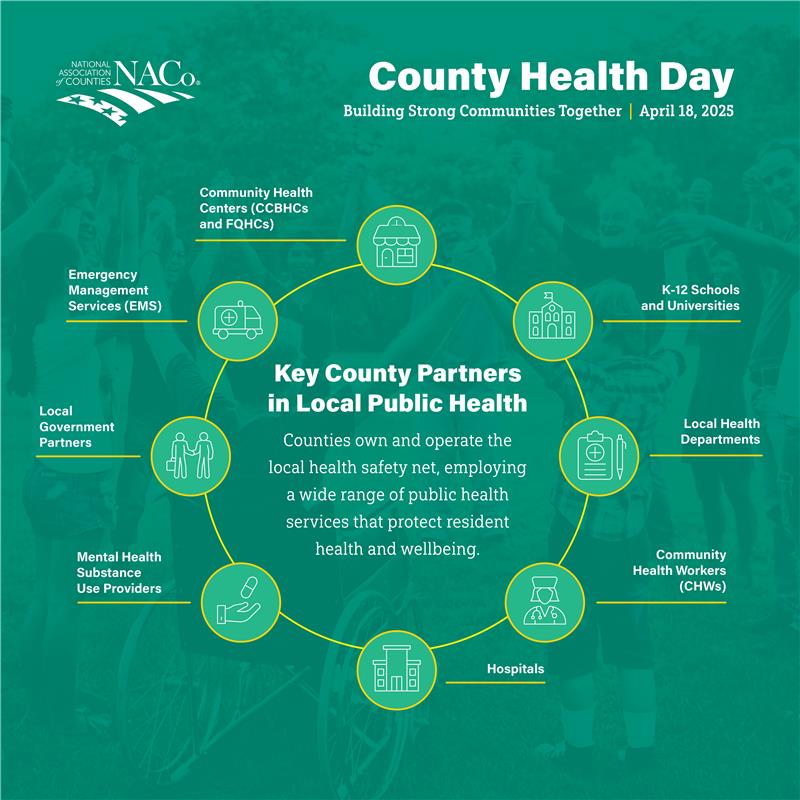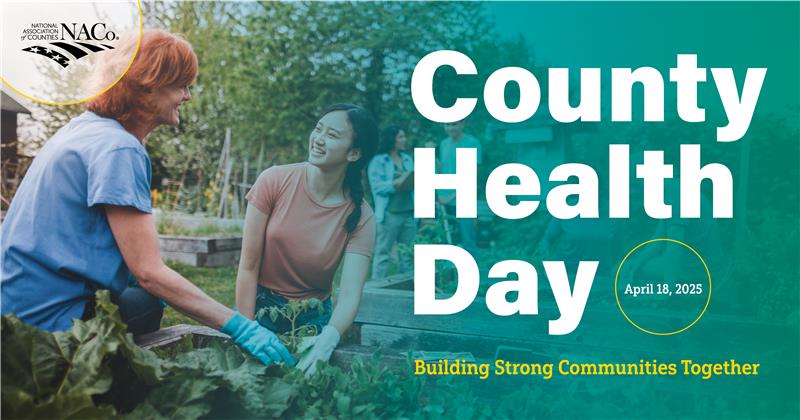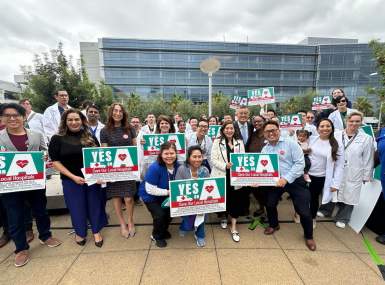Join NACo in celebrating County Health Day on April 18, 2025
Upcoming Events
Related News

Key Takeaways
Please join the National Association of Counties (NACo) in celebrating County Health Day on Friday, April 18th!
County Health Day, which falls during National County Government Month, honors the vital role counties play in supporting health and well-being across every stage of life — from infancy to older adulthood. Under this year’s theme, Counties Supporting Health Across the Lifespan, we are highlighting the essential work counties do to create healthier, more resilient communities for all ages. The focus areas for this year’s celebration include:
- Prevention and Early Intervention: Showcase how counties invest in preventive care — from childhood immunizations to screenings for chronic conditions and mental health — promoting lifelong health and reducing future healthcare costs.
- Healthy Environments: Demonstrate how counties foster environments that support health, including clean water, safe housing, recreational spaces, and food security programs that benefit all generations.
- Resilience and Mental Well-being: Share how counties promote mental health and emotional resilience — through youth support programs, crisis response services, and senior social connection initiatives — supporting well-being at every age.
- Access to Care: Highlight how counties ensure access to essential services like maternal care, mental health supports, chronic disease management, and aging services — making sure no one is left behind at any stage of life.
Show #CountyHealth in Action
Throughout the day, use your social media platforms to share links to publications, photos, program descriptions and stories that capture the impact of innovative public health programs in your community. Connect with counties across the country on Facebook and X (Twitter) by using #CountyHealth to join the conversation and share how you are collaborating, engaging the community, innovating and impacting your community's health.
- Highlight community partnerships. Public health thrives through partnership. Tag and celebrate your community partners — from early childhood providers to senior care advocates — to recognize their role in supporting lifelong health.
- Share county resources. Promote recent county reports, needs assessments, or service directories to raise awareness about available health programs for people of all ages.
- Promote data on county health systems. Share key data from NACo’s resources to show the impact counties have on public health throughout the lifespan.
- Thank county health employees. Celebrate the dedicated county public health workforce — nurses, social workers, health educators, and others — who make a difference across every generation. Recognize individual health champions and share their stories on social media.
Educate Partners on the County Role in Public Health
This brief provides an overview of how counties provide integral public health services for all Americans, describes their public health authority, their role in preparedness and response efforts, and local public health efforts to address social determinants of health (SDOH) in our communities. The brief also outlines key federal policy recommendations for our federal partners to safeguard funding and authority for local public health services and programs.
View NACo Briefs:
- The County Role in Public Health
- The County Role in Long Term Care
- The County Role in Food Systems
- The County Maternal Health Landscape
Share Key County Public Health Stats
- Counties support the majority of America’s approximately 2,800 local health departments and protect our residents’ health, safety and quality of life #CountyHealth
- Approximately 70 percent of all local health departments are county-based, and another 8 percent serve multiple counties #CountyHealth
- Counties are on the frontlines of crises, working alongside state and federal partners to respond to natural disasters and public health threats #CountyHealth
- As owners and administrators of local health and human services systems, SDOH accounts for as much as 50 percent of all county health outcomes #CountyHealth
- Counties play a key role in managing the multiple systems that influence maternal health outcomes #CountyHealth
- Counties invest $83 billion annually in community health and hospitals and contribute $28 billion to Medicaid's non-federal share. Strong federal partnerships are essential to sustain these vital public health services #CountyHealth
- Medicaid enhances access to healthcare for low-income residents, improving health outcomes and reducing uncompensated care costs for county hospitals. Preserving county involvement in Medicaid is crucial for community well-being #CountyHealth
- There are many different partners counties engage with across the local level to promote public health. Check them out: #CountyHealth
Advocate for Key Public Health Priorities
This County Health Day, counties can advocate for strong federal partnerships that empower local public health systems through collaboration, investment, and policymaking that supports a resilient and sustainable public health infrastructure.
- Provide funding and incentives to recruit and retain a diverse public health workforce. Local health departments which are underfunded and understaffed are less likely to be able to prepare and mobilize effectively, leaving our communities incredibly vulnerable. A strong workforce and consistent federal investments are essential to the overall health care infrastructure and ensure that our public health system operates efficiently and effectively.
- Protect funding for core local public health services and prevention programs. Urge your members of Congress, especially those who serve on the U.S. House and Senate Appropriations Committees, to protect and increase funding for local public health services and prevention programs made possible by the Prevention and Public Health Fund (PPHF). Read more here.
- Expand direct to county investments and support for bolstering public health preparedness and response. To meet the needs of residents, the local preparedness infrastructure must be upgraded as communities continue to face numerous environmental and natural disasters, alongside growing public health threats. Federal programs like the Centers for Disease Control and Prevention’s Public Health Emergency Preparedness (PHEP) cooperative agreement program are essential in providing not only funding, but technical assistance and guidance, to help public health departments at all levels to better prepare and respond to public health threats and emergencies.
- Urge federal policymakers to protect county funding and flexibility in Medicaid financing reforms. Counties are essential partners in Medicaid, directly administering and delivering critical health services—any federal financing reforms must protect local flexibility and funding to ensure vulnerable residents continue receiving care.
Access NACo Toolkit: Federal Reforms to Medicaid Financing View NACo Health Policy Briefs
Use NACo's Sample Social Media Posts
Highlighting County Programs
- Today is #CountyHealth Day! [COUNTY NAME] is celebrating [PROGRAM NAME], which supports lifelong health by [DESCRIBE PROGRAM]
- [COUNTY NAME] is joining @NACoTweets in celebrating #CountyHealth Day! We're proud to support residents' health at every stage of life — from early childhood to healthy aging #CountyHealth
- Join [COUNTY NAME] in recognizing #CountyHealth Day and the vital work counties do to support health, safety and well-being across the lifespan
- [COUNTY NAME] is working hard to create healthier communities for all ages. This #CountyHealth Day, check out how we're addressing [HEALTH PRIORITY]: [LINK TO PROGRAM]
Celebrate Partnerships and County Employees
- Thanks to our partner [TAG PARTNER ORGANIZATION] for their support in addressing [INSERT PUBLIC HEALTH TOPIC OF INTEREST] in [COUNTY NAME]! Learn more about our work together [ADD LINK TO PROGRAM/PARTNER PAGE] #CountyHealth
- [NAME OF COUNTY EMPLOYEE] is a champion of supporting health across the lifespan in [COUNTY NAME]. [INSERT SPECIFIC INFORMATION OF EMPLOYEE'S PUBLIC HEALTH WORK/ACHIEVEMENTS] Thank you for your service! #CountyHealth
Check Out NACo's Health Programs

Healthy Counties Initiative
NACo’s Healthy Counties Initiative creates and sustains healthy counties by supporting collaboration and sharing evidence-informed approaches to pressing health issues.
Contacts:

Blaire Bryant

Shalini Wickramatilake
Resource
The County Role in Public Health










